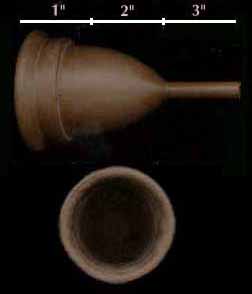Leona
Chalmer's 1937
book with a
drawing of a cup.
And
read comments from people who have
used a cup.
Do cups
cause endometriosis? Not enough evidence,
says the FDA.


|

A History of the
Menstrual Cup (continued)
The Keeper of
the Tradition
 The direct
descendent of the Tassette and
Tassaway is the reusable The
Keeper, which Lou Crawford of
Cincinnati, Ohio, has made since
1987. A smaller version, called B,
for women who have not had
children, appeared in 1989. (The cup end of
A is about one-eigth inch -
about three millimeters - wider
than B. The two varieties are
otherwise the same.) The direct
descendent of the Tassette and
Tassaway is the reusable The
Keeper, which Lou Crawford of
Cincinnati, Ohio, has made since
1987. A smaller version, called B,
for women who have not had
children, appeared in 1989. (The cup end of
A is about one-eigth inch -
about three millimeters - wider
than B. The two varieties are
otherwise the same.)
Because The Keeper is an ongoing
business, Lou was reluctant to
reveal much about her company in
an interview (1998), including
sales.
She did say that she has not
heard of any serious medical
problems associated with its use,
a positive aspect reported by most
cup manufacturers. Lou has asked
that Dr. Philip M. Tierno, Jr., a
member of
the board of this museum and
probably the most prominent
investigator of the safety of
menstrual hygiene products, to
test the cup for safety. Here are
some of Dr.
Tierno's comments. The cup
is made of natural gum rubber.
(Readers have sent comments
about The Keeper, Instead and
other cups to MUM.)
Early on, in searching for a
name for the cup, one group of
women suggested Liberty Bell,
because of its shape. Over the
advertised life of the cup, ten
years, it also liberates its users
from debt, costing around $4 a
year - pretty cheap.
Lou mentioned that the cup and
the bag that carries it are made
in America. Women in neighboring
states make the bags by hand.
Call 1-800-500-0077
(U.S.A. and Canada), Worldwide
voice mail: 1-877-AKEEPER, Fax: (513)
221-1464, e-mail:
[email protected] or write The
Keeper, Box 20023, Cincinnati,
Ohio, 45220 U.S.A. It costs $35
plus $2 shipping.
© 1997-2006 Harry Finley.
It is illegal to reproduce or
distribute any of the work on this
Web site in any manner or medium
without written permission of the
author. Please report suspected
violations to [email protected]
|
|